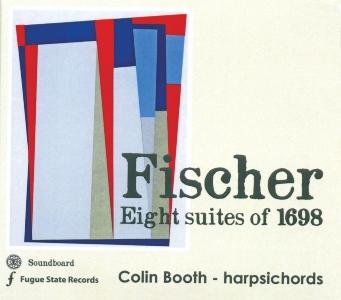Equally at home with historical keyboards and the piano, Michael Delfín is a top prizewinner of the Jurow International Harpsichord Competition and is a member of The Diapason’s 20 Under 30 Class of 2021. Based in Cincinnati, Ohio, he is artistic director of Seven Hills Baroque. Michael Delfín’s website: michaeldelfin.com

A new edition of Mattheson’s Fingersprache
Die Wohlklingende Fingersprache (The Melodious Talking-Fingers), by Johann Mattheson, edited by Colin Booth and Matthew Brown. Soundboard, 2020, 70 pages, with preface in English and German, $37.00. Available from ravencd.com.
Two years ago, the British publishing house Soundboard unveiled a new edition of Johann Mattheson’s largely neglected Die Wohlklingende Fingersprache, best translated as “The Melodious Talking Fingers.” Edited by Colin Booth and Matthew Brown, this publication presents the performer with both a clean reprint of the original 1730s text as well as a historical preface, performance practice suggestions, and critical commentary. Considering the rarity of reliable editions of this work, Soundboard’s issue is a must-have for all historical keyboardists.
German composer Johann Mattheson published the Fingersprache in two halves, in 1735 and 1737, and dedicated it to his one-time rival and subsequently colleague George Frederick Handel. The work consists of twelve fugues as well as various dances and character pieces interspersed throughout the work. A second edition followed in 1749; though merely a reissue of the original with a French title, it specifies the harpsichord as the intended medium for enjoyment. Breitkopf & Härtel presented a new edition just over two centuries later, edited by Lothar Hoffman-Erbrecht, which presented musicians with considerable errors. Booth and Brown have corrected many of these errors, and with the addition of substantial commentary, their work fulfills a need in the historical performance field, particularly in drawing attention to Mattheson’s much-neglected output.
Mattheson’s music utilizes the same vocabulary as that of his German compatriots Handel, Johann Sebastian Bach, and Georg Philipp Telemann, but he developed his own dialect through his fugal writing and often singular dances, both of which reveal a taste for harmony and phrasing bordering on idiosyncratic. The Fingersprache’s creativity in fugal writing constantly entertains the reader, who will encounter various contrapuntal games such as multiple subjects and/or countersubjects within the same fugue, choral-sounding textures thrown in between highly idiomatic keyboard writing, and a rich figural vocabulary stemming from Mattheson’s German roots. In addition, Mattheson demonstrates a thorough knowledge of other styles such as the French clavecinists in Seriosità, an allemande-like character piece, and also a learned style combined with galant virtuosity in Fugue X for three subjects. He nonetheless closes with his Germanic roots in the final fugue, which takes as its subject the chorale tune Werde munter, mein Gemüte.
Booth and Brown provide details of Mattheson’s life that allow the performer some context into the Fingersprache’s origins and transmission. Their commentary situates the collection within the world of Bach and Handel, sometimes comparing the keyboard music of the three but more commonly highlighting the singularity of Mattheson’s unique writing.
As very little performance practice exists specifically for Mattheson’s music, Booth’s brief summary of practices will serve the performer well as a starting point for further exploration. Although sources themselves are left to the performer to explore, any keyboardist who knows of Mattheson will also know of
Carl Philipp Emanuel Bach and likely Johann Kirnberger and other Germans who penned guidance for keyboardists of their day. One might also benefit from consulting Booth’s liner notes from his recent recording of the Fingersprache for a more personal take on the music (see “Harpsichord Notes,” November 2021 issue, page 11). After all, performers are the ones actually getting their hands dirty!
Also included in this publication is a critical report by Brown, complete with a statement of editorial practice. A policy of “refraining from intervention” guided the editors, and their critical report reflects this practice. They state ambiguities in the original edition, rather than merely correcting them without comment, as many twentieth-century urtext editions tended to do. The curious performer may consult the original editions on the International Music School Library Project (IMSLP, imslp.org) to verify accuracy.
Booth and Brown’s publication deserves a place in the library of any serious historical keyboardist. As original sources become more and more easily obtainable, the need for updated, clean editions requires a critical approach to editing. Keyboardists will readily appreciate this painstaking publication that brings to light a neglected yet considerable work of the High Baroque.






